Religion Islam 1375–1378 Bayram Xoca Historical era Middle Ages Founded 1375 | Government Monarchy 1467–1468 Hasan 'Ali Capital Tabriz Date dissolved 1468 | |
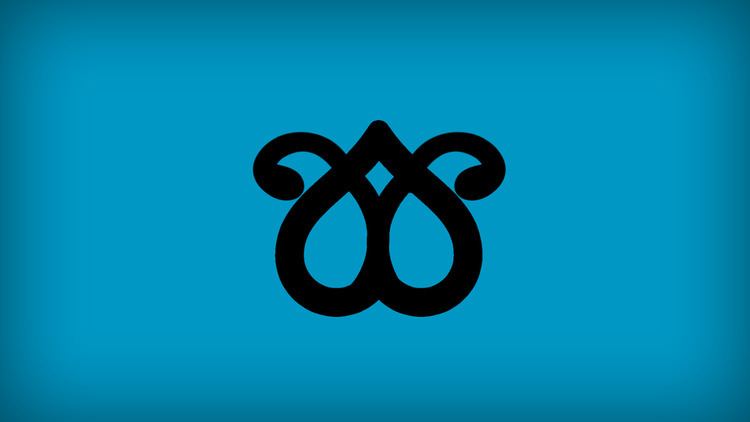 | ||
Languages Azerbaijani (poetry)
Persian (poetry) | ||
The Kara Koyunlu or Qara Qoyunlu, also called the Black Sheep Turkomans (Persian: قره قویونلو), were a Shi'a Oghuz Turkic tribal federation that ruled over the territory comprising present-day Azerbaijan, Armenia (1406), northwestern Iran, eastern Turkey, and northeastern Iraq from about 1375 to 1468.
Contents
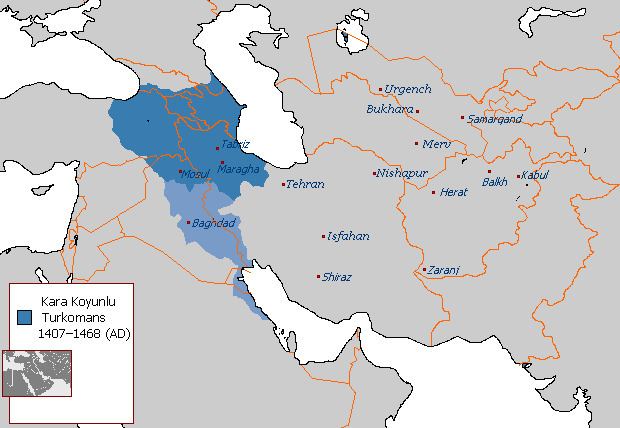
The Kara Koyunlu Turkomans
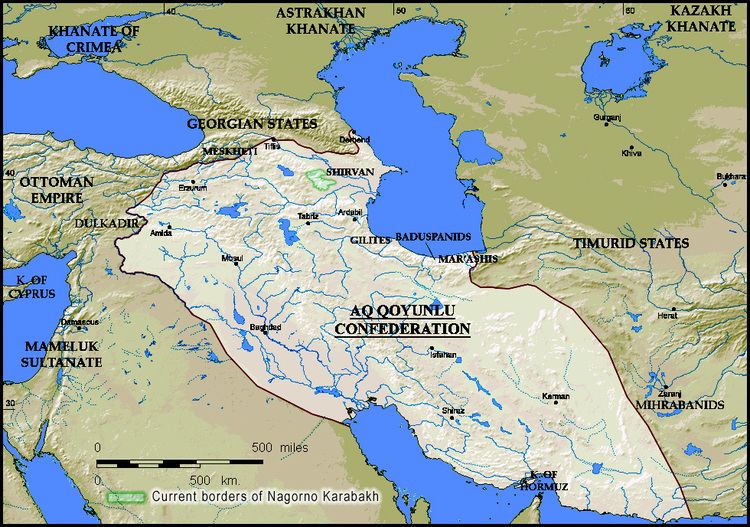
The Kara Koyunlu Turkomans at one point established their capital in Herat in eastern Iran. They were vassals of the Jalairid Sultanate in Baghdad and Tabriz from about 1375, when the leader of their leading tribe ruled over Mosul. However, they rebelled against the Jalairids, and secured their independence from the dynasty with the conquest of Tabriz by Qara Yusuf. In 1400, Timur defeated the Kara Koyunlu, and Qara Yusuf fled to Egypt, seeking refuge with the Mamluk Sultanate. He gathered an army and by 1406 had taken back Tabriz.
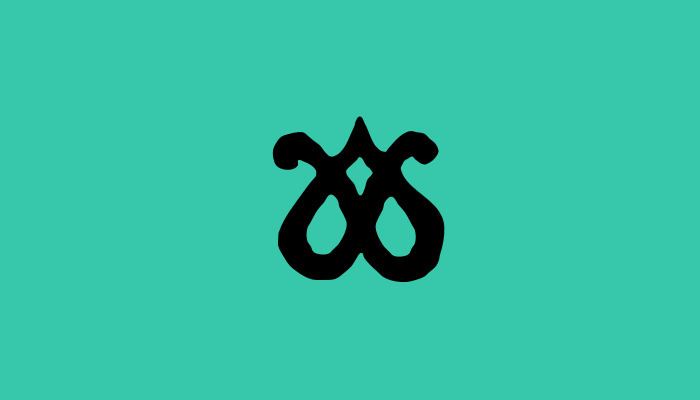
In 1410, the Kara Koyunlu captured Baghdad. The installation of a subsidiary Black Sheep line there hastened the downfall of the Jalairids they had once served. Despite internal fighting among Qara Yusuf's descendants after his death in 1420, and the increasing threat of the Timurid dynasty, the Kara Koyunlu maintained a strong grip over the areas they controlled.
Jahān Shāh
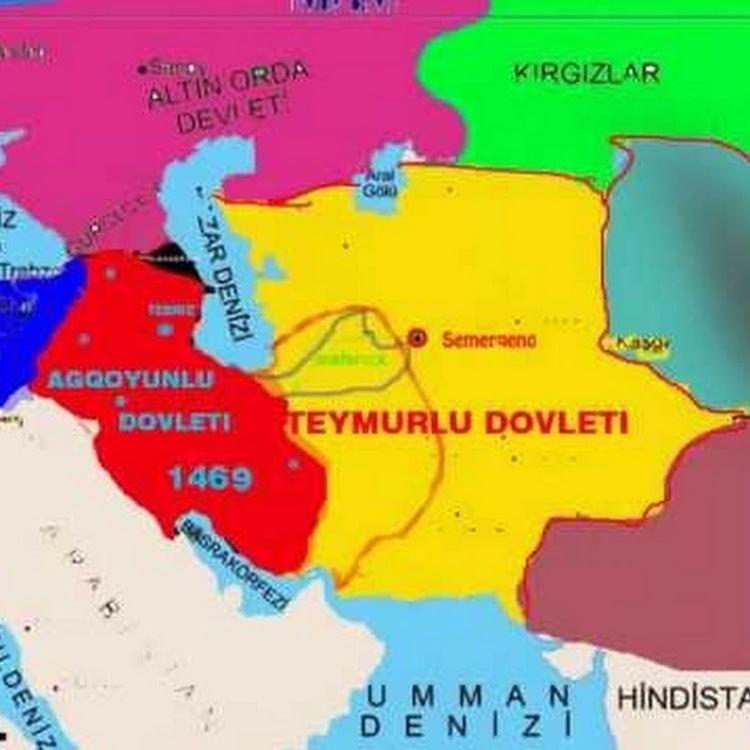
Jahan Shah made peace with the Timurid Shahrukh Mirza; however, this soon fell apart. When Shahrukh Mirza died in 1447, the Black Sheep Turkomans annexed portions of Iraq and the eastern coast of the Arabian Peninsula as well as Timurid-controlled western Iran. Though much territory was gained during his rule, Jahān Shāh's reign was troubled by his rebellious sons and the almost autonomous rulers of Baghdad, whom he expelled in 1464. In 1466, Jahan Shah attempted to take Diyarbakır from the Ağ Qoyunlu ("White Sheep Turkomans"), however, this was a catastrophic failure resulting in Jahān Shāh's death and the collapse of the Black Sheep Turkomans' control in the Middle East. By 1468, at their height under Uzun Hassan (1452–1478), Aq Qoyunlu defeated the Qara Qoyunlu and conquered Iraq, Azerbaijan, and western Iran.
Armenia
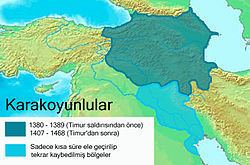
Armenia fell under the control of the Kara Koyunlu in 1410. The principal Armenian sources available in this period come from the historian Tovma Metsopetsi and several colophons to contemporary manuscripts. According to Tovma, although the Kara Koyunlu levied heavy taxes against the Armenians, the early years of their rule were relatively peaceful and some reconstruction of towns took place. This peaceful period was, however, shattered with the rise of Qara Iskander, who reportedly made Armenia a "desert" and subjected it to "devastation and plunder, to slaughter, and captivity." Iskander's wars with and eventual defeat by the Timurids invited further destruction in Armenia, as many Armenians were taken captive and sold into slavery and the land was subjected to outright pillaging, forcing many of them to leave the region. Iskander did attempt to reconcile with the Armenians by appointing an Armenian from a noble family, Rustum, as one of his advisers.
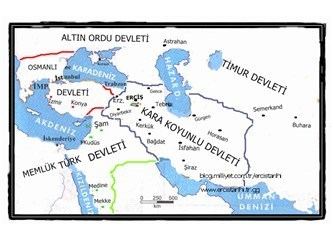
When the Timurids launched their final incursion into the region, they convinced Jihanshah, Iskander's brother, to turn on his brother. Jihanshah pursued a policy of persecution against the Armenians in Syunik and colophons to Armenian manuscripts record the sacking of the Tatev monastery by his forces. But he, too, sought a rapprochement with the Armenians, allotting land to feudal lords, rebuilding churches, and approving the relocation of the seat of the Armenian Apostolic Church's Catholicos to Etchmiadzin Cathedral in 1441. For all this, Jihanshah continued to attack Armenian towns and take Armenian captives as the country saw further devastation in the final years of Jihanshah's failed struggles with the Aq Qoyunlu.
Mausoleum of Turkmen emirs

One of the most prominent monuments built by Black Sheep dynasty remains today in the vicinity of the Armenian capital, the Mausoleum of Kara Koyunlu emirs. Turkmenistan and Armenia both contribute to the restoration and preservation of this medieval piece of architecture.
